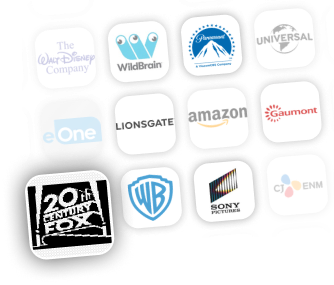Introduction
Hey there, animators and indie creators! You’ve poured your heart, soul, and countless hours into creating amazing independent animation. Now comes the big question: how do you sell independent animation and get it seen by the world (and get paid for it)? It might seem like a daunting task, especially with so much content out there. But don’t worry! This guide is here to help you navigate the process, from polishing your creation to finding the right buyers and platforms. We’ll explore different avenues, essential tips, and how understanding the market can make all the difference. Let’s get your animation out there!
Curious how Vitrina can help you? Try it out today!
Trusted by global entertainment leaders to grow business, acquire high-demand content, promote projects and services, and track every Film + TV production worldwide
Key Takeaways
| Aspect | Description |
|---|---|
| Core Challenge | Getting your unique animated content seen and monetized in a competitive global market. |
| Essential First Steps | Polishing your animation, understanding your rights, and creating a solid pitch package. |
| Key Sales Channels | Distributors, sales agents, streaming platforms (direct submission where possible), animation festivals, and online marketplaces. |
| Marketing & Pitching | Developing a strong pitch, networking effectively, and building an online presence are crucial to sell independent animation. |
| Vitrina’s Role | Vitrina provides market intelligence to help you identify potential buyers, understand content demand, and find distribution opportunities. |
Don't Know Who's Buying Animation Like Yours?

Preparing Your Independent Animation for Sale

Before you even think about who to approach, you need to make sure your animation and your pitch are in top shape. First impressions count, especially when you want to sell independent animation. Proper preparation can significantly increase your chances of success.
Key elements of a polished animation project (story, visuals, sound).
Buyers expect a certain level of quality. Ensure your animation shines by focusing on:
- Compelling Story: Is your narrative engaging? Does it have a clear beginning, middle, and end (if applicable)? Are the characters well-developed? Even for abstract or experimental animation, a clear concept or emotional arc is important.
- High-Quality Visuals: This doesn’t necessarily mean big-budget CGI. It means a consistent and appealing art style, fluid animation, good character design, and attention to detail appropriate for your intended audience and platform. Technical aspects like resolution and format also matter.
- Professional Sound Design: Clear dialogue (if any), fitting music, and effective sound effects are crucial. Poor sound can ruin even the best visuals. Consider professional mixing and mastering.
- Technical Specifications: Ensure your final product meets industry standards for broadcast or digital delivery (e.g., frame rates, aspect ratios, file formats).
Think from a buyer’s perspective: would *you* invest in this content if you saw it? Getting feedback from trusted peers or mentors before you try to sell independent animation can be invaluable.
Creating an effective pitch package: synopsis, trailer, artwork.
Your pitch package is your sales toolkit. It needs to grab attention and clearly communicate what your animation is about and why it’s special. Key components include:
- Logline: A one or two-sentence summary that captures the essence of your animation. Make it catchy!
- Synopsis: A short (usually one-page) summary of the story, characters, and themes.
- Trailer or Sizzle Reel: A short, dynamic video (1-3 minutes) showcasing the best of your animation. This is often the first thing a buyer will look at.
- Artwork/Visuals: High-quality stills, character designs, concept art, and a poster if you have one.
- Creator Bio/Statement: Information about you (and your team, if applicable), your vision for the project, and any previous successes.
- Target Audience Profile: Who is this animation for? Why will they love it?
- Budget Overview (if seeking funding for a larger project based on a short): A realistic breakdown of costs.
Make sure your package is well-organized, professionally presented, and easy to share digitally. This is your first step to successfully sell independent animation.
Understanding your rights and what you are selling.
This is critical! Before you sell independent animation, you need to be clear on what rights you own and what rights you are willing to license or sell. Consider:
- Copyright: Do you own the copyright to all elements (story, characters, music, visuals)? Have you registered your copyright?
- Distribution Rights: Are you selling exclusive or non-exclusive rights? For specific territories (e.g., North America, Europe, Worldwide)? For a limited time period?
- Media Rights: Are you selling rights for theatrical release, broadcast TV, SVOD (Subscription Video on Demand), AVOD (Advertising VOD), educational use, etc.?
- Ancillary Rights: What about merchandising, sequels, or spin-offs? Do you want to retain these?
It’s highly recommended to consult with an entertainment lawyer to understand the implications of any deal before you sign. Being informed about your rights is key to a fair deal when you sell independent animation.
| Preparation Step | Key Focus | Why It’s Important for Selling |
|---|---|---|
| Project Polish | Story, visuals, sound, technical quality. | Meets buyer expectations, showcases professionalism. |
| Pitch Package | Logline, synopsis, trailer, visuals. | Grabs attention, clearly communicates project value. |
| Rights Clarity | Copyright, distribution/media/ancillary rights. | Ensures fair negotiation, protects your IP. |
| Target Audience ID | Demographics, psychographics, viewing habits. | Helps buyers see the market potential. |
Identifying Potential Buyers and Platforms
Once your animation is polished and your pitch package is ready, the hunt for buyers begins. Knowing where to look and who to approach is crucial if you want to successfully sell independent animation. The market is diverse, so research is key.
Who buys independent animation? (Distributors, broadcasters, streamers).
There are several types of entities looking to acquire or license animation:
- Distributors: Companies that specialize in selling content to various platforms (broadcasters, streamers, theatrical exhibitors) across different territories. They often have established relationships and market expertise. A good distributor can significantly expand the reach of your animation.
- Sales Agents: Individuals or companies that act on your behalf to find distribution deals. They typically work on commission and focus on making sales to distributors or directly to platforms.
- Broadcasters: Traditional TV channels (both public and commercial) that acquire animation for their programming schedules. This includes kids’ channels, general entertainment channels, and sometimes niche cable networks.
- Streaming Platforms (OTT Services): Giants like Netflix, Hulu, Amazon Prime Video, Apple TV+, as well as more specialized or regional streamers. Many are actively seeking original and licensed animation.
- Online Platforms & Marketplaces: Sites like YouTube, Vimeo, or specialized animation platforms might offer monetization options or direct sales, though often with different terms than traditional buyers.
- Educational Institutions & Corporate Clients: If your animation has educational value or could be used for training/marketing, these can be potential buyers or licensors.
Understanding the specific needs and acquisition strategies of each type of buyer will help you tailor your approach to sell independent animation more effectively.
Researching platforms and their content needs (genre, length, audience).
Don’t just blindly submit your animation everywhere. Do your homework! When researching potential platforms or buyers:
- Analyze their Current Catalog: What kind of animation do they already feature? Does your project fit their brand and existing content? If they only show preschool animation, your edgy adult comedy is probably not a fit.
- Identify their Target Audience: Who are they trying to reach? Does it align with the intended audience for your animation?
- Look for Submission Guidelines: Many platforms and distributors have specific guidelines for how to submit projects. Follow these carefully.
- Check for Recent Acquisitions or Commissions: What have they bought or greenlit recently? This can indicate current trends and interests. Resources like Vitrina’s solution can provide insights into deals and acquisitions across the industry.
- Consider Content Length and Format: Are they looking for shorts, series, or features? Does your project meet their typical runtime requirements?
Targeting the right buyers increases your chances of a positive response and helps you avoid wasting time. A well-researched approach is vital to sell independent animation successfully.
The role of animation festivals and markets in connecting with buyers.
Animation festivals and markets are invaluable for independent creators looking to sell independent animation. They offer opportunities to:
- Showcase Your Work: Getting your animation selected for a festival can bring it to the attention of buyers, distributors, and industry professionals. Winning awards can further boost its profile.
- Network: These events are packed with people from all corners of the animation industry. Attend panels, workshops, and networking events to make connections.
- Pitching Sessions: Many festivals and markets host formal pitching sessions where creators can present their projects directly to a panel of buyers and commissioners.
- Learn: Gain insights into industry trends, market demands, and what buyers are looking for.
- Meet Distributors and Sales Agents: Many attend these events specifically to find new talent and content.
Major festivals like Annecy, Ottawa International Animation Festival (OIAF), Kidscreen Summit, and MIPCOM/MIPJunior are key events to consider if your budget and project allow. Even smaller, regional festivals can be beneficial.
| Buyer/Platform Type | Typical Content Interest | How They Help You Sell |
|---|---|---|
| Distributors | Wide range; films, series, shorts for various markets. | Handle sales to multiple platforms/territories. |
| Streaming Platforms | Originals, exclusive licenses, library content. | Direct access to large, engaged audiences. |
| Broadcasters | Series, specials fitting their channel brand/demographic. | Reach traditional TV audiences. |
| Festivals/Markets | New talent, innovative shorts and features. | Networking, visibility, direct pitching opportunities. |
Pitching, Negotiating, and Closing the Deal
You’ve done your prep, identified your targets – now it’s time for the crucial steps of pitching, negotiating, and hopefully, closing a deal to sell independent animation. This is where your communication skills and business savvy come into play.
Crafting a compelling pitch: What do buyers want to hear?
When you get the chance to pitch, make it count. Buyers are busy, so be clear, concise, and passionate. They generally want to know:
- What is it? Your logline and a brief overview of the story/concept.
- Who is it for? Your target audience and why they will connect with it.
- Why is it unique? What makes your animation stand out from the rest? (e.g., art style, story, characters, themes).
- What is the potential? Can it be a series? Are there merchandising opportunities? Does it have global appeal?
- Who are you? Briefly introduce yourself and your team, highlighting relevant experience or passion for the project.
- What do you need/want? Be clear about what you’re looking for (e.g., acquisition, licensing deal, co-production).
Practice your pitch until it flows naturally. Your enthusiasm can be infectious! Tailor your pitch slightly depending on who you’re talking to – a distributor might care more about international sales potential, while a streamer might focus on subscriber appeal. Being prepared is key when you aim to sell independent animation.
Tips for effective networking and building industry relationships.
The animation industry, like many creative fields, is relationship-driven. Networking isn’t just about schmoozing; it’s about building genuine connections:
- Be Prepared: Have your elevator pitch ready, and business cards or a digital equivalent.
- Listen More Than You Talk: Show genuine interest in what others do.
- Attend Industry Events: Festivals, markets, conferences, workshops, and even local meetups.
- Use Social Media Professionally: Connect with industry people on platforms like LinkedIn. Share your work and engage thoughtfully.
- Follow Up: If you make a good connection, send a brief follow-up email.
- Be Patient and Persistent: Building relationships takes time. Don’t get discouraged.
- Offer Value: Think about how you can help others, not just what they can do for you.
Strong relationships can lead to opportunities you might not find otherwise when trying to sell independent animation.
Understanding deal terms, contracts, and the negotiation process.
If a buyer is interested, you’ll enter the negotiation phase. This is where things get serious. Key areas to understand include:
- License Fee/Advance: The upfront payment for your animation.
- Royalties/Revenue Share: Potential backend payments based on performance or sales.
- Scope of Rights: Exactly which rights are being granted (territory, term, media, exclusivity). Be very clear on this.
- Deliverables: What technical materials you need to provide, and by when.
- Payment Schedule: When and how you will be paid.
- Marketing Commitment: What, if anything, will the buyer do to promote your animation?
- Creative Approvals (if applicable): For future works or modifications.
- Termination Clause: Conditions under which the agreement can be ended.
Always get legal advice! An entertainment lawyer specializing in animation or film/TV can help you understand the contract, negotiate fair terms, and protect your interests. Don’t be afraid to ask questions or negotiate points you’re uncomfortable with. This is a critical stage when you sell independent animation.
| Stage | Key Objective | Important Tip |
|---|---|---|
| Pitching | Generate interest and a request for more. | Be clear, concise, passionate, and audience-focused. |
| Networking | Build genuine industry connections. | Listen actively and follow up thoughtfully. |
| Negotiation | Secure a fair deal that protects your rights. | Always consult an entertainment lawyer. |
| Closing | Finalize the agreement and deliver materials. | Ensure all terms are clearly documented. |
Turn Your Animated Project into a Success Story!

Leveraging Market Intelligence to Sell Independent Animation
In today’s data-driven world, understanding the market landscape can give you a significant edge when you want to sell independent animation. Market intelligence helps you make informed decisions, identify opportunities, and approach buyers with greater confidence.
How data and insights can inform your sales strategy.
Market intelligence can provide valuable information such as:
- Content Trends: What genres, themes, or styles of animation are currently in demand? What’s performing well on different platforms?
- Buyer Preferences: Which distributors, broadcasters, or streamers are actively acquiring content similar to yours? What are their typical deal structures?
- Competitive Landscape: What other independent animations are out there? How is yours different or better?
- Untapped Markets: Are there territories or platforms where your type of animation might find an audience but is currently underserved?
- Pricing Benchmarks: Understanding typical license fees or sales figures for comparable projects (though this data can be hard to find, trends are useful).
This kind of knowledge helps you refine your pitch, target the right buyers more effectively, and potentially negotiate better terms when you aim to sell independent animation.
Using platforms like Vitrina to find buyers and understand demand.
Platforms like Vitrina are designed to provide exactly this kind of market intelligence for the media and entertainment industry. For independent animators looking to sell independent animation, Vitrina can be a powerful tool by helping you:
- Identify Potential Buyers: Discover companies (distributors, platforms, production houses) that are active in the animation space, including those who have recently acquired or commissioned animated content. You might find buyers you weren’t aware of.
- Understand Content Demand: See what types of animated content are being sought after in different regions or by specific platforms. For example, Vitrina’s Project Tracker can show what’s in development or production, indicating current interests.
- Analyze Platform Catalogs: Get insights into the content mix of various streaming services, helping you determine if your animation would be a good fit.
- Track Deals and Partnerships: Learn about recent acquisition deals, co-productions, and distribution partnerships in the animation sector.
- Discover Niche Opportunities: Uncover smaller, specialized platforms or markets that might be a perfect match for your unique animation.
By leveraging the data and insights provided by a service like Vitrina’s solution, you can approach your sales strategy with more precision, making it easier to connect with the right partners and successfully sell independent animation.
Staying updated on industry trends and opportunities.
The animation industry is constantly evolving. New platforms emerge, viewer preferences shift, and business models change. To successfully sell independent animation over the long term, it’s crucial to stay informed:
- Read Industry Trades: Follow publications like Animation Magazine, Kidscreen, Variety, The Hollywood Reporter, and online animation news sites.
- Attend Webinars and Conferences: Many offer insights into current market trends and future outlooks.
- Follow Industry Leaders on Social Media: Gain perspectives from executives, producers, and creators.
- Monitor Festival Selections and Awards: These often highlight emerging trends and talent.
A continuous learning mindset will help you adapt your strategies and seize new opportunities to sell independent animation as the market changes.
| Market Intelligence Aspect | Benefit for Selling Animation | How Vitrina Can Help |
|---|---|---|
| Content Demand Analysis | Target buyers interested in your animation type. | Insights on genres/themes sought by platforms. |
| Buyer Identification | Find a wider range of potential sales partners. | Database of active animation buyers and distributors. |
| Competitive Analysis | Position your animation uniquely in the market. | Data on existing content catalogs and deals. |
| Trend Spotting | Adapt your projects to current market needs. | Information on new projects, emerging platforms. |
Conclusion
Successfully navigating the path to sell independent animation is a journey that combines creative passion with smart business strategy. From meticulously preparing your project and understanding your rights to identifying the right buyers and skillfully negotiating deals, every step matters. The market is dynamic and full of opportunities for unique voices. By leveraging industry events, building strong networks, and utilizing market intelligence from platforms like Vitrina, you can significantly improve your chances of not just getting your animation seen, but also achieving commercial success. Keep creating, keep learning, and keep pushing to share your animated stories with the world!
Ready to take the next step and find the perfect home for your animation? Visit stg-vitrina-staging.kinsta.cloud to explore how our comprehensive market intelligence can connect you with buyers and help you sell independent animation more effectively.
Frequently Asked Questions
Prices for animated shorts vary wildly based on quality, length, originality, your track record, and the buyer’s needs/budget. It can range from a few hundred dollars for non-exclusive online rights to thousands (or more) if it’s part of a larger acquisition by a major platform or wins prestigious awards. Festivals often offer cash prizes. It’s less about a fixed price and more about finding the right fit and value for a specific buyer.
While not strictly necessary, especially for very short pieces or direct online sales, a good sales agent or distributor can be invaluable for feature films or series. They have industry connections, market knowledge, and negotiation expertise that can lead to better deals and wider reach than you might achieve on your own. However, they take a commission (typically 15-30%). Weigh the pros and cons for your specific project.
Pitching directly to giants like Netflix as an unknown independent animator is very difficult. They usually prefer to work through established production companies, studios, agents, or distributors. The best route is often to build your reputation with successful shorts, gain representation, or partner with a production company that has a relationship with the streamer. Some platforms occasionally have open calls or incubator programs, so keep an eye out for those.
Ideas themselves are hard to copyright, but the expression of an idea (e.g., your script, character designs, completed animation) can be. It’s good practice to register your copyright for completed works. When pitching, you can use Non-Disclosure Agreements (NDAs), but many established companies are reluctant to sign them for unsolicited pitches. Focus on building trust and pitching to reputable entities. Creating a “paper trail” (e.g., dated records of your work) can also be helpful.




























